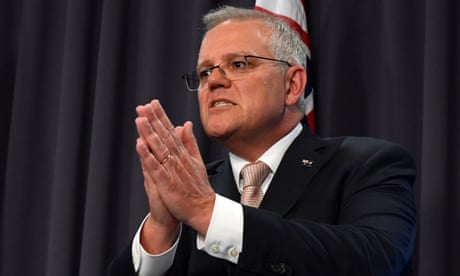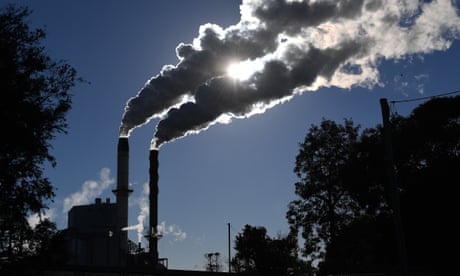Scott Morrison’s government is counting on businesses and households to reduce emissions almost entirely as a result of their own voluntary initiative.

Last modified on Wed 27 Oct 2021 13.04 AEDT
The Morrison government has now confirmed that it will target net zero emissions for Australia by 2050.
But, unlike Europe, the US and China, the Morrison government believes we’ll manage to reduce emissions to zero without implementing any legislation that either requires businesses to reduce their emissions or that of their products; or provides funding to pay these businesses to reduce their emissions at mass scale.
Instead the government has a plan for “technology not taxes”. Underpinning this three-word slogan is the argument that Australian businesses and households will reduce emissions almost entirely as a result of their own voluntary initiative. The government simply doesn’t need to legislate things like renewable energy targets, or emission limits applying to car exhausts or smoke stacks, or even provide rebates to install batteries or buy electric vehicles.

In the government’s favour is that a range of carbon abatement technologies are managing to achieve substantial reductions in costs. As a result both business and household demand for these products has been expanding. One in four Australian homes now have a solar system installed. In addition, we’ve seen a range of a big corporates over the past two years make commitments to offset a substantial proportion, if not all, of their electricity consumption through the purchase of renewable energy certificates. More recently we’ve also seen the price of Australian carbon credits traded above $30, which is far higher than the price the government has been offering to pay via its abatement purchasing auctions of around $16 to $17. Also, some of the world’s biggest motor vehicle manufacturers have indicated their intentions to move most or all of their models to be fully electric over the next 10 to 15 years.
So does this mean the government is off the hook?
Solar headwinds
While solar is now on a fifth of homes, landlords have proven to be utterly uninterested in installing solar or any other energy efficiency upgrades to their rental properties. These represent a third of all households and their share is growing. Also by 2025 solar generation will approach the point where it will regularly exceed overall grid demand during the midday period. This will lead to increasing solar spillage and deteriorating interest in solar systems unless government can spur greater uptake of batteries.
Voluntary offset demand from the private sector remains tiny relative to overall emissions
Green Energy Markets estimates demand for renewable energy outside the legislated renewable energy target is expected to dramatically expand from 688GWh in 2018 to reach 12,662GWh by 2025, after which it stalls. Although 3,600GWh of this is actually as a result of government policies, leaving about 9,000GWh that is driven by private sector voluntary action. That is equal to under 4% of Australia’s total electricity consumption. Now it’s likely that further voluntary commitments to purchase renewable energy will come, but even if we doubled demand it would still be comfortably less than 10% of Australian electricity consumption.
Meanwhile total voluntary demand for Australian carbon credits in 2021 was less than 2 million tonnes according to analysts Market Advisory Group. By 2030 they expect it to grow to roughly about 4 million tonnes which is less than 1% of Australia’s total emissions.

Dramatic reductions are being achieved in Australia’s electricity emissions, but what’s really driving change isn’t so much voluntary demand as government policy. It’s just that policy is coming from state governments. But it would be so much more efficient if this could be done nationally.
Does Australia want to be lumped with the next Betamax video tape?
Given the plans of the world’s major motor vehicle manufacturers Australia will inevitably move to electric vehicles. However, if the Morrison government does little to expand the availability of electric vehicle charging infrastructure, and refuses to upgrade our vehicle emissions standards in line with those overseas, we run the risk of becoming a dumping ground for obsolete oil-fuelled vehicles over this decade. Consumers will initially think this is great as they get cut-price cars. But after 2030 they could find themselves with a vehicle that is the equivalent of a Betamax video tape player in a world of Netflix. That could make keeping that car on the road increasingly expensive, while also leaving Australia with a long-term emissions legacy given how long cars last.
Don’t get too excited about cheap hydrogen
While the Morrison government doesn’t believe it needs to do much to drive adoption of renewable energy or electric vehicles, it has indicated that it will help fund technological research and development of things like hydrogen, carbon capture and storage, low emission metal production and measurement of soil carbon. Yet even if the government was spectacularly successful in achieving its stated cost targets for these technologies, they would still remain financially unattractive. So these will remain left on the shelf without legislation that bridges this cost premium.
Freeloading off the rest of the world
The Morrison government is correct that even if they do nothing, Australia will still significantly reduce emissions from electricity and transport thanks to technological advancements driven by other nations. But for these technological advancements to transpire will require substantial investments and policies that will impose additional costs on these nations, at least in the short term.
While it might seem like it’s worth a try to see if we can get away with it through the government’s technology not taxes plan, do we really want to simply freeload off these other nations when it comes to climate change?
No comments:
Post a Comment